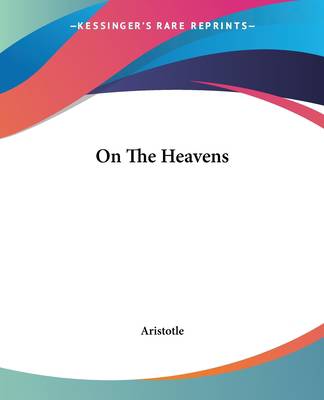
- Afhalen na 1 uur in een winkel met voorraad
- Gratis thuislevering in België vanaf € 30
- Ruim aanbod met 7 miljoen producten
- Afhalen na 1 uur in een winkel met voorraad
- Gratis thuislevering in België vanaf € 30
- Ruim aanbod met 7 miljoen producten
Zoeken
Omschrijving
On The Heavens is a philosophical treatise written by Aristotle, a Greek philosopher, in the 4th century BCE. The book explores the nature of the universe and its celestial bodies, including the stars, planets, and the moon. Aristotle argues that the universe is composed of a series of concentric spheres, with the Earth at the center and the stars and planets orbiting around it. He also discusses the concept of motion in the universe, and explains that the celestial bodies move in a circular motion because it is the most perfect and divine form of motion. The book also delves into the idea of causation, with Aristotle asserting that the movements of the celestial bodies are caused by the actions of the gods. On The Heavens is considered a foundational work in the history of astronomy and cosmology, and has influenced scientific thought for centuries.From one point of view it might seem impossible that the heaven should be one and unique, since in all formations and products whether of nature or of art we can distinguish the shape in itself and the shape in combination with matter. For instance the form of the sphere is one thing and the gold or bronze sphere another; the shape of the circle again is one thing, the bronze or wooden circle another.This scarce antiquarian book is a facsimile reprint of the old original and may contain some imperfections such as library marks and notations. Because we believe this work is culturally important, we have made it available as part of our commitment for protecting, preserving, and promoting the world's literature in affordable, high quality, modern editions, that are true to their original work.
Specificaties
Betrokkenen
- Auteur(s):
- Uitgeverij:
Inhoud
- Aantal bladzijden:
- 88
- Taal:
- Engels
Eigenschappen
- Productcode (EAN):
- 9781419138690
- Verschijningsdatum:
- 17/06/2004
- Uitvoering:
- Paperback
- Formaat:
- Trade paperback (VS)
- Afmetingen:
- 189 mm x 239 mm
- Gewicht:
- 167 g

Alleen bij Standaard Boekhandel
+ 56 punten op je klantenkaart van Standaard Boekhandel
Beoordelingen
We publiceren alleen reviews die voldoen aan de voorwaarden voor reviews. Bekijk onze voorwaarden voor reviews.











